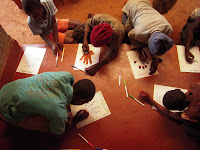This morning, we were greeted at Cura (which, by the way, is reached by a stretch of gutted red road) by Edwin, the new vicar. He had invited us to his home to meet his family, and he instructed us to get back in our car and follow him.
Gilbert (our driver) was game, so off we went back down the rutted red road (with Cura children following, perplexed by our extremely short morning visit) and over the paved road a ways before we turned off for what seemed like AGES of maneuvering increasingly rocky and neglected terrain. It is Saturday here, so the fields we saw out our windows were filled with people hard at work, weeding and harvesting the crops they depend on for both food and income. At one point, we slowed nearly to a stop in order to let a donkey by; it was pulling a cart laden with charcoal and other commodities for the market. Gilbert chuckled under his breath, and said he was reminded of an adage: Treat a donkey well, and he will treat you well. He was filled with folksy commentary, actually, as he noted the work ethic clearly in place in this predominantly Kikuyu region. Gilbert is a Luo, a tribe that has been disgruntled, to say the least, with Kikuyus through Kenya’s history… But Gilbert thought that old resentment might be put to rest if “more Kenyans went for a drive out here and saw how Kikuyus live.”
We were, of course, eager to arrive at Edwin’s shamba to see how he and his family live… and, sure enough, Gilbert had even more to be impressed about. Edwin and Rachel, his wife, have a small plot of land that is adjacent to that of each of his brothers and his father. On this plot, they proudly keep 5 cows, 20 pigs and 250 chickens, at last count, and they and their three daughters work from 5am to milk cows, harvest eggs, prepare the day’s feed and other chores before walking the surplus to the market for some additional income.
After all of that, Edwin drives the chassis-brutalizing route to Cura to begin the morning’s duties in the parish office, observing, learning about and responding to the concerns of his “flock.”
Not being Anglicans ourselves, we weren’t sure what to expect from Edwin in terms of his observations about Cura and/or his commentary about how to address its challenges. After today, even Gilbert was happy to have sustained ample wear and tear to his taxi in order to hear Edwin talk in such measured, creative and energetic terms about how he can make a meaningful impact on the community there. He spoke about the particular challenge of integrating the various generations into the common and substantial work of the community. He commended Moses and his generation for being the caretakers, and he recognized the young people as the future workforce and leadership of the area. He wondered, though, where the adults between the ages of 25 and 40 had gone… Some have died prematurely (hence, the orphanage!), but, as he says “we have not put every one in the ground as of yet.” He takes as his personal focus the closing of this gap: bringing what adults still hover around Cura into partnership with the young and the old so that the solutions to Cura’s problems are shared by a group of people who can sustain each other into the future. We look forward to tracking his success!
Once we said our thank yous and goodbyes to the Kinyanjuis, we made our way back down and then back up the red roads between there and Cura… and got back in time to spend the afternoon variously playing games, making art projects and taking care of some administrative business.
Scola, my partner in the pen pal program and the computer lab instructor, helped us manage the children rotating through the art and photography stations, while Grace (one of the house mothers) led singing and dancing and still found time to serve us a heaping plate of ugali and sukuma wiki. Delicious and filling!
The day was chaotic and demanding: those of us with children at home know what it can be like to be on call for every need throughout the day – and imagine that times 50! Though the children are self-sufficient and have plenty of care throughout the day, they were also excited to show us the new skills they had acquired (bicycles, bicycles, bicycles), make plans for when we come back on Monday (pen pal letter-writing, another art project, a shamba walk, and more) and generally get us caught up on what they need (Stephen wants a pen pal that will write more often; Sharon wants a scrunchy to finish off the braid she put in my hair; Minnet just wants Norman to come back, in the worst way; Naomi wants more paper and pens to draw her flowers in peace and quiet; Grace wants to get good enough marks on her final exams to earn a place in a prestigious Nairobi secondary school; Simon wants to become an even better dancer; Minne really wants to be excused from Sunday school… ).
Asking questions and listening to the children was the major focus of the day, and the afternoon passed swiftly! By the time we sat with Scola (my pen pal program partner) for sweet, black tea and hot, fresh chapati, we were exhausted!
I left amid reassurances that we’d be back on Monday, and that I’d have another craft project to do together (it’s bookmarks… don’t tell!). I also left with two small treasures: gifts from Esther and Grace that were so beautifully wrapped that I waited until I got back to Nairobi to open the packages so that I could photograph them before I ruined them in the unwrapping.
H




No comments:
Post a Comment